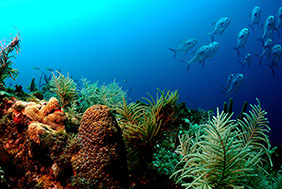-
Home
-
Data & Publications
-
Regional Portals
- About Regional Portals
- Florida
- Navassa Island
- Puerto Rico
- Flower Garden Banks
- U.S. Virgin Islands
- American Samoa
- Commonwealth of the Northern Mariana Islands
- Federated States of Micronesia
- Guam
- Main Hawaiian Islands
- Republic of the Marshall Islands
- Northwestern Hawaiian Islands
- Republic of Palau
- Pacific Remote Island Areas
-
CRCP Activities
- Glossary
Guam
Guam, a United.States. unincorporated territory, is the southernmost island in the Mariana Archipelago. It is located in the western Pacific approximately 3,700 miles west-southwest of Honolulu, Hawaii; 1,500 miles east of Manila; and 1,500 miles south-southeast of Tokyo, Japan. It is the largest island in Micronesia, with a land mass of 216 mi2 and a maximum elevation of approximately 405 meters. It is also the most heavily populated island in Micronesia with a population of about 168,000 people (July 2018 est). The northern portion of the island is relatively flat and consists primarily of uplifted limestone. The southern half of the island is primarily volcanic, with more topographic relief and large areas of highly erodible soils. This topography creates a number of watersheds throughout the southern areas which are drained by 96 rivers.
The condition of Guam’s coral reefs (including fringing reefs, patch reefs, submerged reefs, offshore banks, and barrier reefs) varies considerably, depending on a variety of factors including geology, human population density, degree of coastal development, levels and types of marine resource uses, oceanic circulation patterns, and frequency of natural disturbances (e.g., storms and earthquakes). Many of Guam’s reefs have declined in health over the past 40 years. However, in the past, Guam’s coral reefs have recovered after drastic declines. For example, an outbreak of the crown-of-thorns seastar in the early 1970s reduced coral cover in some areas from 50 to 60% to less than 1%. Twelve years later, greater than 60% live coral cover was recorded for these areas. A more distressing indicator of the condition of Guam’s coral reefs is the marked decrease in rates of coral recruitment.
Reefs unaffected by sediment, nutrient loading, and freshwater runoff in the northern part of the island and between river outflows, have relatively healthy coral communities. The reefs have not suffered the large scale bleaching events and coral diseases seen in other parts of the world. Unfortunately, some reefs have been damaged by land-based sources of pollution and heavy fishing pressure.

Guam satellite map
Highlights
OCM Coastal Impact Stories: Coral Reef Conservation Program in Guam
Coral Reef Condition: A Status Report for Guam (2018)
Publications
Successive bleaching events cause mass coral mortality in Guam, Micronesia (2019)
Guam's Coral Reef Management Priorities (2010)
Guam Capacity Assessment Report and Coral Reef Conservation Time line
Guam Coral Bleaching Response Plan (April 2017)
Design and Parameterization of a Coral Reef Ecosystem Model for Guam
The economic value of Guam's coral reef
Status of coral reef fish assemblages and benthic condition around Guam: A report based on underwater visual surveys in Guam and the Mariana Archipelago, April-June 2011 U.S. Dept. of Commerce, NOAA Technical Memorandum NOAA-TM-NMFS-PIFSC-33, 22
Report on the Status of Marine Protected Areas in Coral Reef Ecosystems of the United States.
Volume 1: Marine Protected Areas Managed by U.S. States,Territories, and Commonwealths. NOAA Technical Memorandum CRCP 2 February 2007
Guam’s 5-Year Coral Reef Initiative Program
Potential larval sources, destinations, and self-seeding in the Mariana Archipelago documented using ocean drifters (Journal of Oceanography, 2014)
Field Identification Guide to the Threatened Corals of the U.S. Pacific Islands

Acropora retusa from Guam. Photo copyright David Burdick.
Status Reports
Coral Reef Condition: A Status Report for Guam (2018)
State of The Reefs Report (SOTR)
The State of Coral Reef Ecosystems of the United States and Pacific Freely Associated States: 2008.
The State of Coral Reef Ecosystems of the United States and Pacific Freely Associated States: 2005.
The State of Coral Reef Ecosystems of the United States and Pacific Freely Associated States: 2002.
Watershed Management Plans
Piti-Asan watershed management plan
A GIS-based watershed management plan for the Piti-Asan watersheds
Draft Conservation Plan for the Piti Bomb Holes Marine Preserve and Adjacent Watershed
Metadata, Data and Publications Search in CoRIS
Search the CoRIS Geoportal for Guam metadata, data and publications
ReefBase Coral Bleaching Reports -
Select "Micronesia" in the Region window and "Guam" in the Country window
Near-real-time Data
Coral Reef Watch Satellite Monitoring
Coral Reef Watch - Mariana Islands and Guam
The Global Temperature-Salinity Profile Program
USGS Water Resources - Data for Guam
NOAA CO-OPS Tide data
NOAA Tide Predictions - Guam
Other Data
Guam Coastal Atlas - The atlas provides benthic habitat maps and geospatial data for the nearshore waters of Guam.
Natural Resources Atlas of Southern Guam
Digital Atlas of Northern Guam
Coastal Guam Aerial Imagery Project
Pacific Islands Benthic Habitat Mapping Center - Guam
Guam and the Northern Mariana Islands Environmental Sensitivity Index (ESI) Atlas
Government of Guam's Map Viewer-
USGS Projected Flood Extent for Guam
Coastal Change Analysis Program (C-CAP) Landcover Data - Guam
- 2005 Guam High Resolution Land Cover
- 2011 Guam High Resolution Land Cover
- 2016 Guam High Resolution Land Cover
- 2005-2016 Guam High Resolution Land Cover Change
Pacific Islands Ocean Observing System Data Portal - Guam
Education and Outreach
University of Guam Marine Laboratory
Marine Protected Areas/Marine Managed Areas
Marine Protected Areas of the United States Home Page
The Marine Protected Areas Inventory
Marine Federal Areas Fact Sheet
Executive order 13158: Marine Protected Areas
Guam information including list of MPAs
Haputo Ecological Reserve Area
Orote Peninsula Ecological Reserve Area
Piti Bomb Holes Marine Preserve
Research in Guam’s Marine Protected Areas: Piti Bomb Holes Reserve


